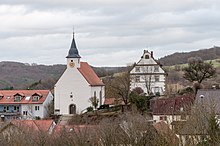Jagstberg Office
The Jagstberg office was an office of the Würzburg monastery .
function
In the early modern period , offices were a level between the municipalities and the sovereignty . The functions of administration and jurisdiction were not separated here. The office was headed by a bailiff who was appointed by the rulers. The Jagstberg office was also a central office , that is, a district of the high court.
history
The core of the exercise of power in the area was Jagstberg Castle . According to Würzburg, the castle and town were founded by the Knights Templar and fell to Würzburg in 1310 as part of the dissolution of the order. The castle was built by the lords of Jagstberg, who, according to the coat of arms, were related to the lords of Langenburg. 1275 was Albert of Ebersberg the castle to the Bishop of Wurzburg to fief on which a part of the Lords of Hohenlohe-Brauneck belehnte. In the following centuries, pledges and redemptions took place several times; in the end the office was undisputedly Würzburg.
In addition, the Office Jagsberg administered the würzburgische district on ganerbschaft Künzelsau . On September 9, 1499, Bishop Lorenz von Bibra acquired Killian von Stetten's share in the city. In 1531 Würzburg acquired another part of von Stetten's share. With Würzburg, Mainz, Hohenlohe and von Stetten there were only four Ganerbe left.
The statistics of the Hochstift Würzburg from 1699 name 329 subjects in 1 city and 8 villages. As annual revenues of the high pin from office (incl. Künzelsau) were moved: estimate : 54 Reichstaler and smoke pounds : 326 pounds.
The Reichsdeputationshauptschluss transferred the office to Hohenlohe-Jagstberg in 1803 . This new line of the House of Hohenlohe was created through an inheritance: Ludwig Aloys von Hohenlohe-Waldenburg-Bartenstein received the possessions around Bartenstein and his younger brother Karl Joseph von Hohenlohe-Bartenstein-Jagstberg received the rule of Oberbronn in Alsace. The Jagstberg office was part of the compensation for the dominion of Oberbronn annexed by France.
In 1806 the office came to the Kingdom of Württemberg and there to the Oberamt Nitzenhausen .
scope
At the end of the HRR , the office comprised the city of Jagstberg , the estate of the Hochstift in the city of Künzelsau and the villages of Americhshausen , Hohenroth , Mulfingen , Ochsenthal , Seitelklingen , Simprechtshausen and Zeißenhausen .
cent
The official places except Mulfingen and Zeißenhausen belonged to the cent. In addition, in 1699 the following belonged to Cent (in brackets the sovereignty): Ailringen (German Order), Alkertshausen (Würzburg, Hohenlohe, Rothenburg), Adolzhausen , Berndshausen , Berndshofen , Büttelbronn , Deibhof , Dürsel (Würzburg), Eisen (huts) rod , Gerolzhausen , Hohebach (Hohenlohe), Hohenlohe (Brandenburg), Heimhausen , Heßlach (shof) , Holderbach , Stielings (Hohenlohe), Holzhausen , Holzleiten (Hohenlohe), Karlozhausen , Linenberg , Monbrunn , Neugereuth , Niederndorf , Obereschbach , Ohrbach , Rauenthal , Rockelshausen , Seidelbrunnen , Spelt , Teichelbrunn , Weldingsfelden , Westernholz , Windischhohenbach , Zwernberg .
At the end of the HRR, in addition to the official locations, the following were named as Centorte: Altershausen , Adolzhausen, Bereshofen , Berndshausen, Braunsbach , Büttelbronn, Daibhof , Dornberg , Dürzel , Eisenrod , Epelt , Geroldshausen , Heimhausen, Hetzlach , Hollenbach , Holzhausen , Holzleiden , Linnenberg , Mannbrunn , Matsingen , Meisberg , Neuenthal , Neugereuth , Oberaschach , Ohrbach , Raroldshausen , Riederndorf , Rockelshausen , Seidel- or Malberbrunn , Seyling , Simmertshausen , Teilgelbrunn , Weldingsfelden, Weserholz , Windischhohenbach, Zweerenberg and Zaisenhausen .
The central court was held in private law matters at the town hall and in criminal matters in the open air near the linden trees in front of the Jagsberger Tor towards Mulfingen.
Office building
The office building, built in 1614 under Bishop Julius Echter , has served as a parsonage since 1781.
See also
literature
- Johann Kaspar Bundschuh : Office Jagstberg . In: Geographical Statistical-Topographical Lexicon of Franconia . tape 6 : V-Z . Verlag der Stettinische Buchhandlung, Ulm 1804, DNB 790364328 , OCLC 833753116 , Sp. 370 ( digitized version ).
- Gregor Schöpf: Historical-statistical description of the Hochstift Würzburg, 1802, p. 611, digitized .
- Alfred Schröcker (editor): Statistics of the Hochstift Würzburg around 1700, ISBN 3-8771-7031-5 , pp. 102-104.
Individual evidence
- ↑ Alfred Schröcker (editor): Statistics of the Hochstift Würzburg around 1700, ISBN 3-8771-7031-5 , p. 102.
- ↑ Jagstberg at leo-bw.de
- ↑ Hans-Joachim Zimmermann: Courts and execution sites in Hochstiftisch-Würzburg administrative and rural sites, Diss. 1976, p. 137


